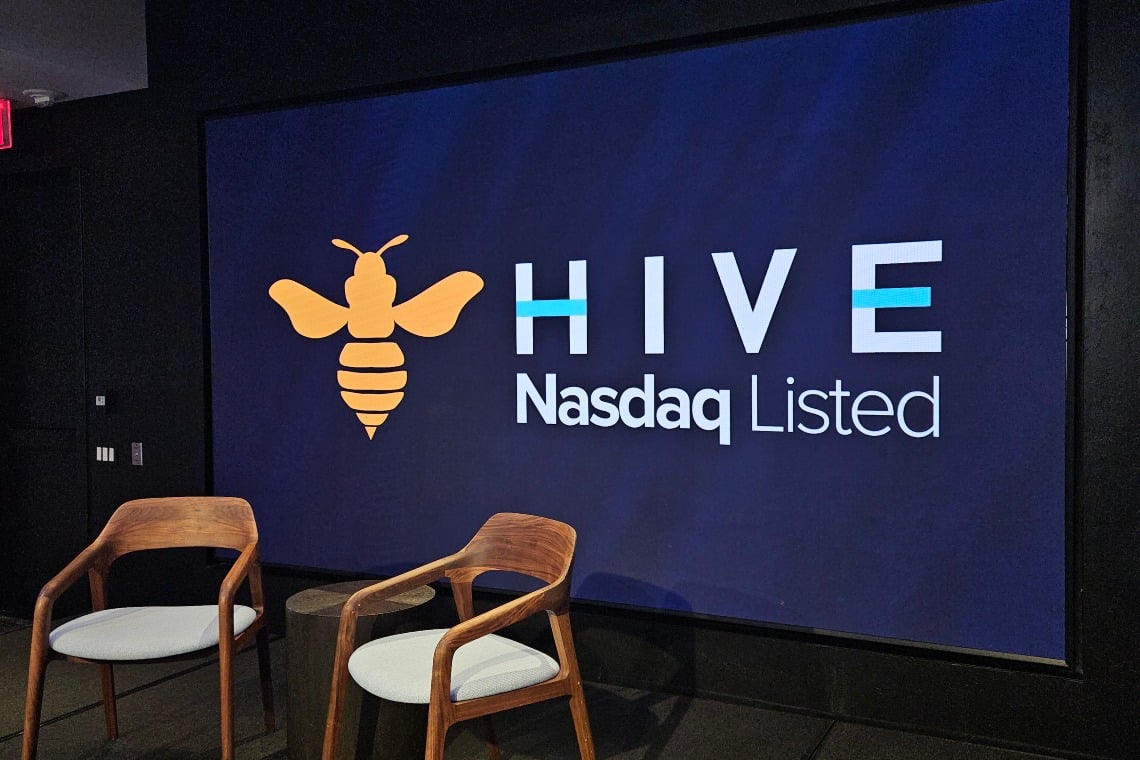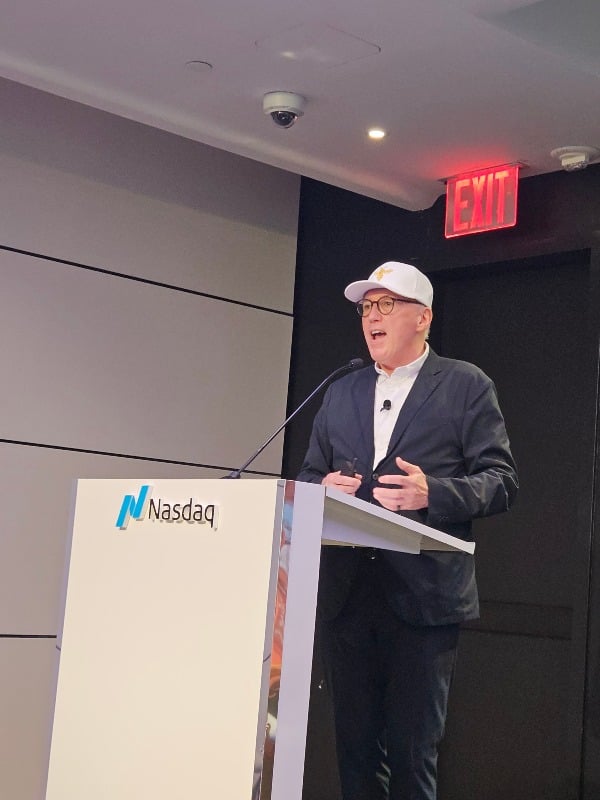4 Years on Nasdaq and the Importance of Green Energy

On July 17, Hive Digital Technologies celebrated its fourth anniversary of listing on Nasdaq in New York City with an event called Hive Day, during which Executive Chairman Frank Holmes outlined the company’s achievements since its founding in 2017.
Below is our interview with Holmes.

What should our readers know about Hive?
In 2017, Bitcoin was trading around $3,000. I was trying to launch a Bitcoin ETF, but I realized the regulatory environment wouldn’t allow it—mainly because of KYC and AML concerns. So I thought, okay, but if you’re a Bitcoin miner, you’re creating a virgin coin and you don’t face KYC or AML issues.
That’s when I launched the first publicly traded crypto mining company in the world. After that, others followed, raising capital to enter the Bitcoin space. But we were the first, and we were also the only green mining company at the time.
We started in Iceland, then expanded to Sweden—very close to the Arctic Circle near Facebook’s data center. From there, we grew into Canada: we’re in Maine, New Brunswick (on the border with Maine), and also Montreal, Quebec.
We were also the first to collaborate with Intel on an ASIC chip, because we’re green. At one point, we were the largest Ethereum miners, and although Ethereum mining has since ended, it gave us valuable experience with GPU chips—knowledge that has now allowed us to move into AI.
We currently operate AI infrastructure in downtown Sweden and Montreal, and we’re expanding into Toronto. As for our Bitcoin operations, after Russia’s invasion of Ukraine, energy costs skyrocketed, making green energy harder to access.
That’s when we turned to Paraguay. I flew down last year, met the country’s president, and decided we would expand there—where we can secure 300 megawatts of electricity.
Now, we’re the fastest-growing Bitcoin miner in the world. As a public company, we’re projected to reach around 3% of the global Bitcoin network by October or November.
We have a strong balance sheet and the lowest mining costs in the industry. I’m proud of that.
We operate with a small team and are celebrating four years listed on Nasdaq. We were first listed in Canada, then here in the U.S., and also in Frankfurt. We trade on all three exchanges. Over the past three months, we’ve doubled production—from 3 Bitcoin per day to 6.5. Within six weeks, we expect to reach 9 Bitcoin per day.
What about AI?
AI relies on GPU chips. Ethereum mining also used GPUs, so back in 2017 we became the first public company—and the largest—to mine Ethereum. That gave us deep expertise in handling GPUs.
Think of GPU chips as managing a Ferrari—they’re sensitive. In contrast, ASIC chips are more like a Jeep or a Bronco—built for rugged terrain. They require different mechanics, different handling.
Now with AI, we’re using Nvidia chips, which are more like a Bugatti.
We’re buying our own data centers: we’re expanding 6 megawatts in Boden, Sweden, and close to another 7 in Toronto. These AI data centers bring in significant revenue.
Here’s the math for your audience: 100 megawatts of Bitcoin mining produces the same revenue as just 10 megawatts of AI infrastructure.
Today marks your fourth anniversary being listed on Nasdaq.
Yes. And we’re a small team—similar to how Tether operates. I was really impressed last year at the Plan B event. We operate like Navy SEALs—not like a large army. We’re highly specialized and focused on execution.
To give you some numbers: last year, we generated \$115 million in revenue, with \$57 million in EBITDA. Even after that, we had an operating income of \$250 million—with just 25 employees.
By Thanksgiving, we expect to hit $450 million in revenue and $250 million in EBITDA. At a 10x multiple, the company would be worth \$2.5 billion. There’s been a recent acquisition—Core Scientific was taken over. If we apply a 15x multiple like that, we’re talking over $12 per share.
So, we’re deeply undervalued compared to the market. We’re in a unique position, and this is a transformational year. Our daily revenue will rise from \$350,000 to \$650,000, and potentially hit \$1 million per day if Bitcoin stays at current levels.
Sustainability is a key aspect of your company. How do you respond to those who say Bitcoin is a waste of energy or highly polluting?
My background is in gold. And if you compare energy usage in gold mining, it’s actually much higher than Bitcoin.
Globally, major banks consume far more energy. In my view, much of the criticism around Bitcoin’s energy use is a negative narrative pushed by bank lobbying groups—starting in Switzerland, with the Bank for International Settlements and other major institutions.
Why? Because Bitcoin is transformative—it allows people to move money globally, freely.
And now, with this new “Genius Act” in the U.S., stablecoin regulation is going to change worldwide. Adoption will only grow.
Take Paraguay, for example—we give back to the community. We’ve helped with education, installed air conditioning in all local schools. The mayor told us women didn’t feel safe due to poor lighting, so we lit up the entire town.
We don’t see banks doing that. Banks aren’t lighting villages or improving safety. Bitcoin miners are. In Montreal, we recycle the heat from our mining operations to warm a building where 175 Whirlpool employees work—saving them money.
So, when I hear criticism, I call it FUD.
You mentioned regulation. It has changed a lot over the past four years. Do you see it as a good thing?
Absolutely. We experienced what’s called “Chokepoint 2.0,” where regulators tried to impose rules through enforcement—not legislation. No elected official passed those rules, they were just enforced through lawsuits.
That happened in Sweden and Canada. They tried to demoralize the industry by saying “Bitcoin is bad.” A year ago, that was happening in the U.S., too.
But now, that’s changing—and it’s transformative. Regulation around stablecoins will evolve globally. The U.S. dollar, as a stablecoin, will continue to grow. And that strengthens the Bitcoin ecosystem.
Bitcoin is a tool to preserve purchasing power and grow wealth. Gold is about asset protection—but Bitcoin does both.
Central banks use gold to preserve value, but they’re not growing wealth for Bitcoiners. Bitcoin, on the other hand, offers 24/7 trading. BlackRock’s CEO is now pushing tokenization in the U.S., and it’s already happening in Europe—Robinhood and Kraken are leading that.
All of a sudden, people are realizing Bitcoin is the backbone of this transformation.
With Robinhood, you can now buy an ETF and for $1,000, you’re getting 900,000 satoshis. It’s like a penny stock. If one satoshi reaches a penny, Bitcoin is worth a million dollars.
So yes, ETFs will accelerate adoption. The new U.S. government policies coming out this week will change the global landscape.
Do you see any downside? For example, do you think BlackRock and other big players are monopolizing Bitcoin?
No, I don’t. The ETFs are relatively free-flowing. BlackRock and others just want to grow assets under management, regardless of where they come from.
For BlackRock, Bitcoin has been a marketing windfall. Their CEO has never received this much free publicity—thanks to Bitcoin.
Being on CNBC and Bloomberg every week talking about tokenization is huge.
As someone who comes from the gold world, we always talked about wealth preservation. But in crypto—especially Bitcoin—the real issue isn’t CPI. It’s purchasing power.
The CPI is managed by the government and always lags reality. The real inflation people feel—look at the cost of eggs, for example—far exceeds what the CPI suggests.
So when people ask, “Where is my purchasing power going?”, they realize inflation isn’t 3–4%, it’s more like 10–12%.
That’s when they turn to Bitcoin.
